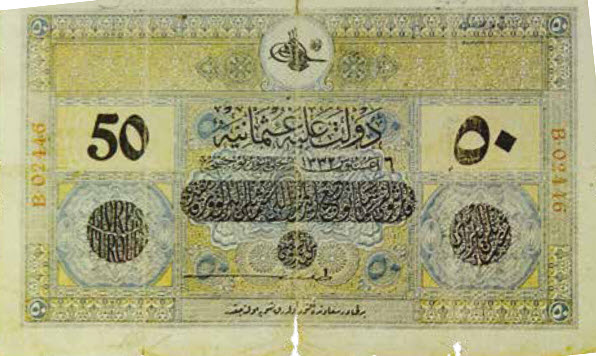A Forgery Story: the First Counterfeit Note of the Ottoman Empire

Being a member of the Axis armies, the Ottoman Empire fought in many fronts during World War I; the Çanakkale Front was one of them. This story takes place during the last days of the war. The Ottoman army did not let Allied Forces pass through the Çanakkale Strait at the expense of thousands of casualties. Those were the last days of the Çanakkale War. Allied Forces withdrew their navy after their unsuccessful attempts to cross the strait, both via the sea and by land. After this the Ottoman troops, along with their arms and ammunition, were deployed to other fronts where Ottoman armies were still fighting. The ammunition was mainly carried by trucks given by the Germans, across mainly stabilized roads. After some time the tires of the trucks needed to be changed. Istanbul was the closest and only city where someone could find tires for the trucks, and so army headquarters decided to assign an officer to buy and fetch the tires as quickly as possible. They found a 19 year old volunteer officer named Mehmet Muzaffer who was born and bred in Istanbul. It was decided that it would be easier for him to find the right place to buy tires and follow all purchasing procedures at the Ministry of Defence.
Mehmet Muzaffer found the tires for which he was looking at a Jewish traders store in Karaköy, İstanbul. They were very expensive because of wartime conditions. After a long bargaining process they shook hands. Mehmet Muzaffer went directly to the Ministry of Defence Headquarters to get the money he needed to complete the transaction. The officer at the logistics department inspected the documents carefully and and asked him: “What are you going to buy?” “Truck tires,” he replied. Upon hearing this answer the officer frowned and angrily said “Look son: I am in dire need of finding money to feed and clothe our troops. Who cares of truck tires at a time like this?” Needless to say, he did not approved the payment.
With empty hands, Mehmet Muzaffer walked through the streets of Istanbul thinking of a solution to his problem, and eventually a plan popped into his head. He went to the Jewish traders store and told him that he would get the money late that evening but he had no place to store the tires so he would come to take them very early in the morning with the payment. They agreed to meet early the next morning. Then he went to several stationary stores to find the right paper and ink to fulfill his plan. Finally he found a paper which was similar to the ones used in the printing of Ottoman paper money. That night he sat at his desk and imitated Ottoman 100 Kaime which was equal to 100 golds by using only ink all night.

The Ottoman government had printed paper money on which they wrote “Provisions will be paid as gold in Istanbul” as wartime measures. When imitating that part Mehmet Muzaffer changed the sentence to “Provisions will be paid as blood in Çanakkale”. Early in the morning he went to the store with a truck he had commandeered from a military unit. After loading the tires into the truck he gave 100 Kaime to the trader. Due to dim light maybe trader did not notice what was written on the paper, and he even paid back change to Mehmet. Mehmet Muzaffer happily got on the truck and rushed to the harbour to get on a boat which was about to leave for Çanakkale. After a few days the trader went to the Ottoman bank to collect his gold. It was not long thereafter that he was informed the money was counterfeit. He was then informed that there was no 100 Kaime note released by the government, and that the highest denomination was 50 Kaime at that time. As it turns out, Mehmet Muzaffer was aware that he couldn’t imitate two 50 Kaimes notes in one night so he decided to invent this new 100 Kaime. The trader did not say much upon being informed about the counterfeit money, but the news travelled fast and the story was heard by everyone living in Istanbul.

The news also made it all the way to the palace. The Sultans son, Şehzade Abdülhalim Efendi, called the Jewish trader to the palace and re-paid the 100 gold that were owed to the trader in return for Mehmet Muzaffer’s 100 Kaime banknote. He took this banknote and put into a velvet box; after some time he donated it to the museum at the Istanbul Police Academy. Mehmet Muzaffer became a commissioned officer in the following year and was assigned to a unit on the Sina front in the Middle East. He was shot in battle and died with the rank of lieutenant in 1917.
The Police Academy , along with its museum, moved to Ankara in 1970. Mehmet Muzaffer’s 100 Kaime is still being kept in a special room at the academy with a high level of security since the time it was donated to the museum. There is no information about the condition of the banknote since then. In order to help you to visualize the whole story, feel free to click the link given below. It is a commercial of a Turkish national tire factory retelling this same story.
Petlas Reklamı Bedeli Çanakkale'de Kanla Ödenecektir (in Turkish)
The link below is a video that shows where the banknote is kept at the moment, and you can hear the story in Turkish.
Bedeli Çanakkale'de ödendi (in Turkish)





